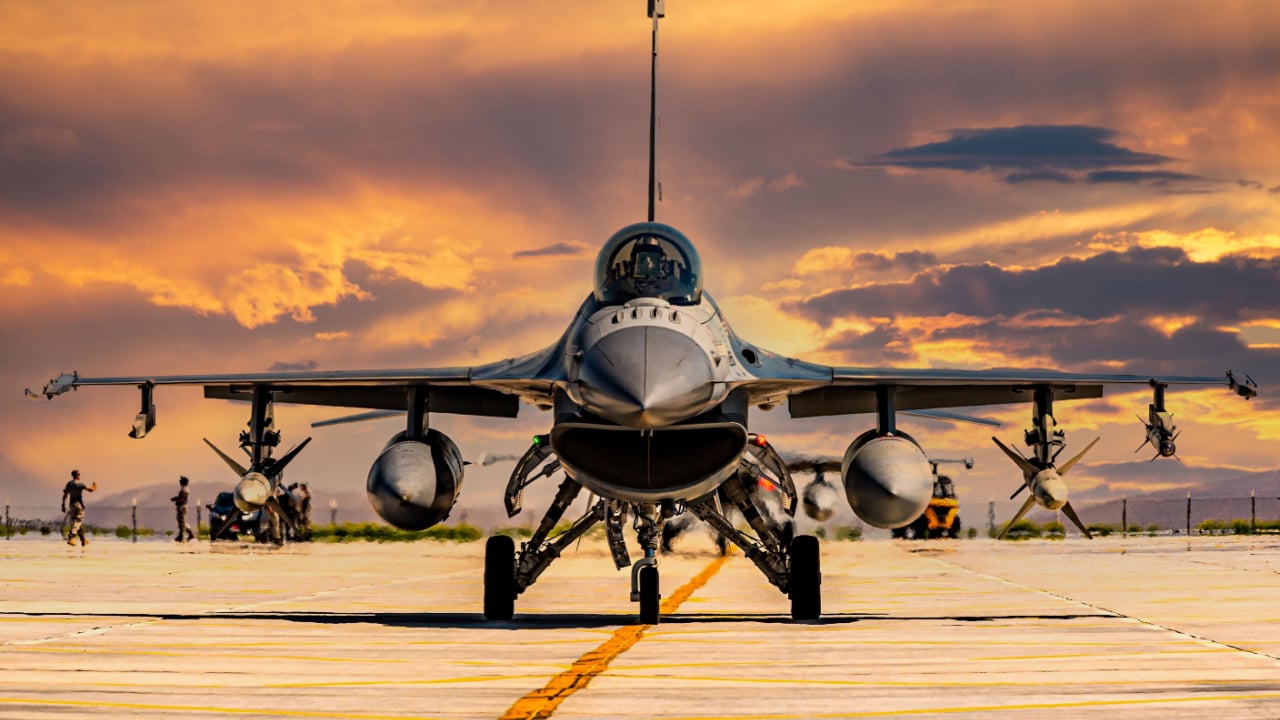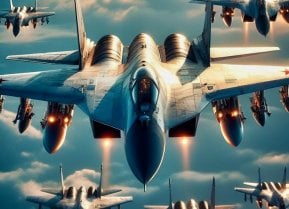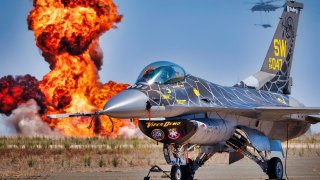Vought Model 1600: Fly the F-16 Fighter From an Aircraft Carrier?
To meet the needs of the U.S. Navy on an aircraft carrier, the Vought 1600 was significantly larger than the original Fighting Falcon, stretching the airframe by some three feet, with a 33-foot 3-inch wingspan that was a full two feet broader than the Air Force's version of the fighter.
Since entering service in 1979, the General Dynamics F-16 Fighting Falcon has been battle-tested, engaging in more than 400,000 combat sorties, and has a combined 19 million flight hours. It has been adapted to complete several mission sets, including air-to-air fighting, ground attack, and electronic warfare. As a combat fighter, the F-16 has proven to be highly maneuverable while its combat radius exceeds that of its potential threats.
It has seen service in the air forces of 25 countries, a testament to what is easily the world's most successful, combat-proven multi-role jet fighter ever produced. As of 2015, it was the world's most numerous fixed-wing aircraft in military service, with more than 4,600 produced, and it seems unlikely it will relinquish that title anytime soon!
The fast and agile F-16 Fighting Falcon isn't just one of the top fighters it is also among the most cost-effective. While it lacks the range and payload of the larger twin-engine F-15 Eagle, it also costs less than half – which is why the fourth-generation F-16 has been in use since the 1970s and will likely keep flying for many more years to come.
Moreover, while it was designed as a land-based fighter, there was even an attempt to develop a carrier-based version.
Meet the Vought Model 1600 - Fly The F-16 from an Aircraft Carrier?
Understanding how a carrier-based derivative was almost developed requires looking back on how the General Dynamics YF-16 was chosen by the Air Force over the Northrop YF-17 in a lightweight fighter "fly-off," and becoming the F-16 Fighting Falcon.
Soon after the F-16 won the U.S. Air Force's new Air Combat Fighter (ACF) contract in 1975, then-Secretary of Defense James Schlesinger pushed the U.S. Navy to adopt the new fighter as well. Schlesinger reasoned that the aircraft could fill a similar role for the U.S. Navy, and in the process streamline logistics for both services.
As Defense Media Network reported, in August 1974 Congress had already directed the Navy to look to the LWF/ACF program’s competitors for its new Navy Air Combat Fighter (NACF) program, which had superseded the Navy's own VFAX program, begun several months before, in April 1974, to replace the F-4, A-4, and A-7 aircraft on carrier decks.
Yet, there was still the aforementioned FY-17, and Northrop wasn't going down without a fight. There was an issue both companies had to address, however.
Neither General Dynamics nor Northrop had ever built a carrier-based jet fighter before.
A lucrative contract was on the line, and each of the firms sought out partners with carrier aircraft experience. General Dynamics teamed up with Vought to convert the new F-16 Fighting Falcon into the Vought Model 1600, while Northrop paired off with McDonnell Douglas to improve upon their YF-17 design.
In the case of Vought, it had designed the successful carrier-capable F-8 Crusader and A-7 Corsair II for the U.S. Navy. Its Model 1600 was based on the Block 10 F-16 – and featured structural strengthening, an arrestor hook, and a more robust undercarriage to accommodate the rigors of carrier launch and recovery operations.
While three powerplant choices were considered, the Vought 1600 was powered by a Pratt & Whitney F401afterburning turbofan.
A Fighting Falcon on Steroids
To meet the needs of the U.S. Navy, the Vought 1600 was significantly larger than the original Fighting Falcon, stretching the airframe by some three feet, with a 33-foot 3-inch wingspan that was a full two feet broader than the Air Force's version of the fighter.
In addition, the breadth of the wings was also increased, covering a total of 269 feet and giving the aircraft better stability at lower speeds. The fuselage was flattened a bit and made broader, and its canopy was designed to pivot forward, which was different from the F-16.
Yet, even with the increased size, the Vought 1600 had many issues that it couldn't overcome.
As others have previously reported, its low-lying intake located just above the nose wheel was considered a real risk on the flight deck of a Navy carrier, as it could literally suck unsuspecting sailors straight into it.
Moreover, the F-16's lightweight design and lack of radar-specific weapons made it poorly suited for all-weather operations including intercepting fighters or bombers en route to a carrier strike group. By contrast, the YF-17 offered a second engine, which could mean the difference between getting a jet back to its carrier or having to dump it in the sea if anything went wrong with one of them.
In the end, the U.S. Navy preferred a twin-engine aircraft, among other factors, and on 2 May 1975, it selected the Northrop-McDonnell Douglas YF-17-based Model 267 proposal, which became the F/A-18 Hornet. That was the beginning of nearly 40 years of U.S. Navy Hornet operations, from F/A-18A/B/C/D Hornets to F/A-18E/F Super Hornets, and then EA-18G Growlers.

At the same time, the F-16 evolved into a true multirole aircraft gaining Sparrow capability, and then, the even better, AMRAAM capability. Perhaps it was the best – as each service had an aircraft designed for their respective needs!
Author Experience and Expertise
Peter Suciu is a Michigan-based writer. He has contributed to more than four dozen magazines, newspapers, and websites with over 3,200 published pieces over a twenty-year career in journalism. He regularly writes about military hardware, firearms history, cybersecurity, politics, and international affairs. Peter is also a Contributing Writer for Forbes and Clearance Jobs. You can follow him on Twitter: @PeterSuciu.
All images are Shutterstock.


